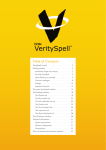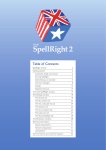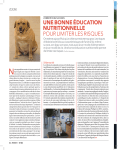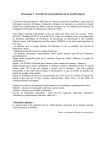Download 6. Living in your SFA – troubleshooting
Transcript
6. Living in your SFA – troubleshooting How to identify and fix some problems yourself. Plumbing Noticed a leak coming through a ground floor ceiling? Is the bathroom above? Before calling us, have you checked the area affected for the source of the leak? Are you able to contain it? It might be that the silicone seal needs replacing or some tiles around the bath may be loose. If this is the case, avoid using the shower until our plumber has been to assess the problem. You may use the bath, but be careful not to splash water around the silicone seal/ tiles. Once you have all the relevant information, give us a call (0800 707 6000) and a job will be logged for you. Finding your hot water is too hot? You need to make sure that the cylinder stat is pushed right against the cylinder so that it touches the rear of the cylinder itself. If everything looks as it should and the problem is still there, give us a call on 0800 707 6000, and an advisor will log a fault for you. Constant sound of running water from the toilet? To stop the overflow running, you need to isolate the water supply to the toilet by using the isolation valve on the supply pipe or for older toilets, the stop tap. Once the water is isolated, a plumber will be able to fix the problem with the overflow. Call the Helpdesk on 0800 707 6000 and a visit will be arranged. Heating Combi boiler not working? Error code showing? Before you call the Helpdesk, have you tried re-setting the boiler? If an error code is showing, have you consulted the manual? If you have done all of this and the problem is still there, call the Helpdesk on 0800 707 6000, explain the problem to the advisor and they will arrange a visit for you. Gone to turn the heating on and found the programmer display blank? Have you tried re-setting the programmer to see if this sorts the problem? Done this but the problem is still there? Give the Helpdesk a call on 0800 707 6000 and we will arrange for an engineer to come and take a look. Gas Safety Inspection has taken place and now you have no heating? Make sure the thermostat is at the right settings Central heating boiler for the boiler to work; this may sometimes be adjusted when the inspection is carried out. If everything looks normal but you still have no heating, give us a call on 0800 707 6000 and we will arrange an appointment for you. Got no heating or hot water at all? Have you checked the pilot light? Is it still lit? If not, try reigniting the boiler and see if the pilot light comes back on. If nothing works call the Helpdesk on 0800 707 6000 and an advisor will sort out a visit for you. 15 40 20 50 60 70 80 moved? If required adjust and the door should be lockable. If it is not, please call us and we can arrange for a visit. 30 10 Radiator One radiator causing a problem and not heating up? If you have thermostatic radiator valves (TRVs) it may be that the pin has become stuck. Take the lid off the valve, and, with the top lightly tap the pin underneath. Place the lid back and you should be able to adjust the settings. If the problem persists, call the Helpdesk (0800 707 6000) and we’ll see what we can do. Doors and windows Window or door catching and not closing fully? In warm weather, due to expansion, hinges tend to stick which causes difficulty when opening and closing doors/windows. Towards the end of the day, when it gets cooler, it should be easier to operate. If not, and the problem is still there, give the Helpdesk a call on 0800 707 6000 and we will sort something out for you. Front or back door difficult to operate? Have you checked the door frame at the leading edge of the door to see if the keeps have 16 Can’t lock the door? Double check that the handle has been fully lifted – sometimes they can stick – and try again. If you’ve done this and it’s still a problem, call the Helpdesk and a visit will be arranged. Got the key in the lock but it won’t turn? Check the lock barrel doesn’t move forward and backwards slightly. If it does, slowly push forwards while applying a small amount of force to turn the key. The lock may line up and engage. If the problem persists please call us on 0800 707 6000 so we can arrange an appointment for you. Electrical Partial power loss to the house? Have you reset the consumer units by pushing the toggle switch back up to the on position? If the switch trips again, appliances on that circuit need to be unplugged and then the switch reset again. You then need to go round plugging in the appliances one by one; when it trips, the potential faulty appliance can be identified. If you’ve done all of this and still can’t identify the problem, call the Helpdesk (0800 707 6000) and an electrician will be called for you. Having problems with your electric cooker? ON Check to see if the cooker switch is off at the OFF COOKER wall. If not, check the clock is set. If the clock is not set, the cooker may not work. You also need to ensure the circuit breaker (switch on fuse board) is in the on position in the consumer unit. If all looks normal and the cooker is still not working, give us a call on 0800 707 6000 so we can arrange an appointment for you. Electric shower not working? Check to see if the pull cord is switched on and lights appear (if present) on shower unit. If this doesn’t work, please call the Helpdesk on 0800 707 6000 and an advisor will arrange a visit for you. Is the immersion not heating the water? Follow the cable from the immersion cap, usually located on the top of the hot water cylinder. The cable should terminate into a switch mounted on the wall. If this switch is off, turn on and the water should get hot after 30 minutes. If, after this time, you still have a problem, please call us on 0800 707 6000. Total loss of power to your house? Are your neighbours having the same problem? If all power is off to your property and properties surrounding you then the electricity supplier should be contacted. Contact numbers should be on bills or correspondence received from them. If you don’t have any paperwork handy, see if a neighbour is home as they might have some details. Failing that, if you still have access to the internet, try searching for your supplier and their contact details. Pest control Managing ants in and around your home At certain times of the year ants can become a pest and enter the home. Generally, they are harmless but they aren’t the most pleasant house guests. Ants are attracted to food left around the house, fruit bowls, petfood and leftover takeaway containers and packaging. Even if there are tiny particles they will be attracted by this and make their way into your house. Some key points to avoid and remove ants: • always make sure no food is left out around your house • if you notice a small crack in a wall or skirting board where ants have been entering your house, place some sticky tape over the hole • if they are regularly entering your home they will be following a scent trail left by other ants. You can try using some natural repellents such as sprinkling some salt, turmeric powder or paprika. This will disturb the trail previously set out and confuse other ants • purchase some relatively inexpensive ant powder from a local DIY retailer and place powder around the area where they are getting in • try to determine the external entrance point for the ants and again treat this with bleach or powder. Once treated put some sticky tape over the area. • if they are generally in and around your garden, there is little we can do to resolve the issue. The best remedy is to dispense some ant powder around the main area of activity. wash off mould on walls or window frames using a domestic mould and mildew remover following manufacturer’s instructions. During warmer periods, ants can swarm as part of the mating cycle. They will normally appear en masse. Again, use ant powder or, if safe to do so, hot water will disperse them. If you continue to have problems, please call the Helpdesk on 0800 707 6000. The advisor will take some details and if necessary your Accommodation Officer will visit with a damp meter to determine the likely cause of the problem. Managing condensation in your home Condensation is produced when warm moist air or steam meets a cold surface such as windows, walls or floors. If left, this can lead to mould on walls and potentially damage clothes and furnishings. Controlling condensation and mould is a matter of minimising sources of water vapour within the home and finding the right balance between heating and ventilation in the home. In addition, our website contains useful suggestions on ways to combat condensation problems. Some general tips: • do not put damp clothes over a radiator • ventilate rooms by opening the window slightly to allow moist air to escape – particularly in kitchens and bathrooms • check you have extractor and/or trickle vents and that they are not blocked • use extractor fans in kitchens and bathrooms • maintain your house above the temperature of 15°c • mop up condensation with kitchen towel and Safety checks It is vital – for us as well as you – to keep your property running safely and efficiently. We carry out a number of safety checks and inspections during the lifetime of your property (for further details see the CarillionAmey website). The most important of these are: • annual gas safety inspection • annual oil-fired boiler inspection • periodic electrical inspection. Important When you receive your request for these annual inspections, you should arrange appointments swiftly and ensure that you are available. Serving personnel are able to take time off work to attend them, once they have cleared the details with their chain of command. These checks are essential for your safety and the safety of your neighbours. 17 20 30 10 Helping us to help you Before you call us, here are some things to check. If you are able to describe the problem clearly, it helps us to help you. Boiler and central heating system Typical faults: • pilot light will not ignite • central heating boiler faulty • communal heating defective • radiator not heating up • radiator leaking • fumes appear in room • storage heater defective • radiant heater faulty Is only one radiator affected? • is it turned on by an individual thermostatic valve? • is this at the correct setting? Water systems 40 50 60 70 80 Central heating does not come on: • is the boiler functioning? • is the water tank hot? • is the room thermostat on its lowest setting? If so try raising the temperature setting on the control • is the circulation pump running? (you will feel a slight vibration if you put your hand on it) 20 Leaking toilet • where is the leak coming from (pan or cistern)? • is the pan cracked? • is it your only toilet? • can you stop the leak? • is it a handle or chain flush? • what floor is the toilet on (ground or first)? • is the seat broken or missing? Water supply If you experience a sudden loss of water supply, you should ascertain whether it is your house alone that is affected by asking a neighbour if they are experiencing the same problem. If other properties are affected you should contact your local water provider. If the loss of water seems to be isolated to just your property, please contact the Helpdesk. Electrical systems Electricity consumer unit 40 50 ON 30 10 40 50 OFF COOKER 60 70 80 The meter may be mounted externally or internally. It is the point of entry of the electricity supply to your SFA. 40 Economy 7 temperature controller 50 60 70 80 Drainage/waste system 20 10 18 20 10 30 30 60 70 80 ON ON OFF COOKER OFF COOKER 20 30 10 40 50 60 70 80 Trip switch Cartridge type fuse Rewirable type fuse 40 Socket not working: • are the lights working? • if so check the consumer unit/fuse box – the fuse for the sockets may have tripped (the electrical circuits are usually separated between upstairs and downstairs) • have you tried another socket? Note: some sockets also have additional fuses built in, e.g. cooker sockets Individual appliance does not work • is there power to the item? (try plugging something else that works into the socket) • is it the item or the switch that is broken? 40 50 6070 40 80 40 20 Electricity meter 30 10 ON ON OFF COOKER OFF COOKER ON OFF COOKER Typical electrical faults: • no power at all • partial loss of power e.g. light circuit failed • electrical fitting smoking • fluorescent tube not working • plug socket failed • appliance not working • smoke detector defective • extractor fan faulty • carbon monoxide warning going off – fault or genuine warning Loss of electrical power: • has all power gone or is it only your property that has lost power? • check if your neighbours have power • check main switch hasn’t tripped and try to reset 50 50 50 60 70 80 6070 80 6070 80 Doors and windows Sash window Pivot window Tilt and turn window Casement window (seen from outside) Reporting window faults: • what type of window is it? • what is it made of – wood/uPVC? • what exactly is wrong – broken sash cord/ catch/stay, broken glass, rotten frame, condensation in double glazing, etc. • will the window close/ open? • can it be secured? • which floor is it on? 20 30 10 ON OFF COOKER Reporting external door faults: • is your home secure? • which door is faulty? • do we need to gain access? External door 19 40 50 6070 80 Faulty/damaged internal doors • is the door sticking or jamming? • is the door damaged? • is the door latch defective? • is the frame loose or damaged? Kitchen fittings and appliances Kitchens - common faults • damaged cupboards • damaged drawers • sink blocked • sink unit leaking (where?) • seal gone around sink (mould in cupboard below?) • sink tap dripping • tap loose ON OFF COOKER Internal doors Is the door: • sticking/jamming? • damaged? • latch/lock defective? • what is the door made of – wood/uPVC? • does the lock go into the keep? • do the keys operate the lock? • is the door frame damaged? Mixer tap 20 Bib tap Modern pillar tap Drawers – defining damage: • whole drawer/front of drawer • bottom of drawer • steel or plastic runners • drawer sticking Cupboards – defining damage: • type – floor, wall or larder unit • double or single High-neck pillar tap Standard pillar tap Supatap














